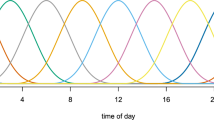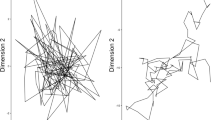Abstract
This paper presents statistical methodology to analyze longitudinal binary responses for which a sudden change in the response occurs in time. Probability plots, transition matrices, and change-point models and more advanced techniques such as generalized auto-regression models and hidden Markov chains are presented and applied on a study on the activity of Rhipicephalus appendiculatus, the major vector of Theileria parva, a fatal disease in cattle. This study presents individual measurements on female R. appendiculatus, which are terminating their diapause (resting status) and become active. Comprehending activity patterns is very important to better understand the ecology of R. appendiculatus. The model indicates that activity and non-activity act in an absorbing way meaning that once a tick becomes active it shows a tendency to remain active. The change-point model estimates that the sudden change in activity happens on December 10. The reaction of ticks on acceleration and changes in rainfall and temperature indicates that ticks can sense climatic changes. The study revealed the underlying not visually observable states during diapause development of the adult tick of R. appendiculatus. These states could be related to phases during the dynamic event of diapause development and post-diapause activity in R. appendiculatus.
Similar content being viewed by others
References
H Akaike (1973) Information theory and an extension of the maximum likelihood principle BN Petrov F Csàki (Eds) Second international symposium on information theory Akadémiai Kiadó Budapest 267–281
VN Belozerov (1982) Diapause and biological rhythms in ticks FD Obenchain R Galun (Eds) Physiology of Ticks Pergamon Press Oxford
DL Berkvens RG Pegram J Brandt (1995) ArticleTitleA study of the diapausing behavior of Rhipicephalus appendiculatus and Rhipicephalus zambeziensis under quasi-natural conditions in Zambia Med Vet Entomol 9 307–315 Occurrence Handle1:STN:280:BymD2cjjtFE%3D Occurrence Handle7548950
DL Berkvens DM Geysen G Chaka M Madder JR Brandt (1998) ArticleTitleA survey of the ixodid ticks parasitising cattle in the Eastern province of Zambia Med Vet Entomol 12 234–240 Occurrence Handle10.1046/j.1365-2915.1998.00106.x Occurrence Handle1:STN:280:DyaK1cvgslKisA%3D%3D Occurrence Handle9737594
P Duffett-Smith (1985) Astronomy with your Personal Computer Cambridge University Press Cambridge
P Guttorp (1995) Stochastic modeling of scientific data Chapman and Hall London
I Hodek (1996) ArticleTitleDiapause development, diapause termination and the end of diapause Eur. J Entomol 93 475–487
R Ihaka R Gentleman (1996) ArticleTitleR: A language for data analysis and graphics J Comput Graphics Stat 5 299–314
P Lambert (1996) ArticleTitleModeling irregularly sampled profiles of non-negative dog triglyceride responses under different distributional assumptions Stat Med 15 1695–1708 Occurrence Handle10.1002/(SICI)1097-0258(19960815)15:15<1695::AID-SIM320>3.0.CO;2-8 Occurrence Handle1:STN:280:ByiD3M7otVc%3D Occurrence Handle8858791
JK Lindsey (1999) Models for repeated measurements EditionNumber2 Oxford University Press Oxford
JK Lindsey (2001) Nonlinear models for medical statistics Oxford University Press Oxford
JK Lindsey B Jones (1998) ArticleTitleChoosing among generalized linear models applied to medical data Stat Med 16 59–68
RJ List (1951) Smithsonian meteorological tables. Smithsonian miscellaneous collections Smithsonian Institution Washington
IL MacDonald W Zuchini (1997) Hidden Markov and other models for discrete-valued time series Chapman and Hall London
J MacLeod (1970) ArticleTitleTick infestation patterns in the southern province of Zambia Bull Entomol Res 60 253–74
M Madder N Speybroeck J Brandt L Tirry I Hodek D Berkvens (2002) ArticleTitleGeographic variation in diapause response in the African brown ear tick Rhipicephalus appendiculatus (Acari: Ixodidae) Exp Appl Acarology 27 209–21
RG Pegram BD Perry FL Musisi B Mwanaumo (1986) ArticleTitleEcology and phenology of ticks in Zambia: seasonal dynamics on cattle Exp Appl Acarology 2 25–45 Occurrence Handle1:STN:280:BieB2c3jsVw%3D
RG Pegram ET Mwase D Zivkovic F Jongejan (1988) ArticleTitleMorphogenetic diapause in Amblyomma variegatum (Acari: Ixodidæ) Med Veter Entomol 2 301–7 Occurrence Handle1:STN:280:By2C1M%2FmtVc%3D
RG Pegram DS Banda (1990) ArticleTitleEcology and phenology of cattle ticks in Zambia: Development and survival of free-living stages Exp Appl Acarology 8 291–301 Occurrence Handle1:STN:280:By%2BB2snhtVc%3D
NJ Rosenberg BL Blad SB Verma (1983) Microclimate: The Biological Environment EditionNumber2 John Wiley and Sons New York
NJ Short RB Floyd RAI Norval RW Sutherst (1989) ArticleTitleSurvival and behavior of unfed stages of the ticks Rhipicephalus appendiculatus, Boophilus decoloratus and B. microplus under field conditions in Zimbabwe Exp Appl Acarology 6 215–236
N Speybroeck M Madder P Bossche ParticleVan Den J Mtambo N Berkvens G Chaka M Mulumba J Brandt L Tirry D Berkvens (2002) ArticleTitleDistribution and phenology of ixodid ticks in southern Zambia Med Veter Entomol 16 1–12
Author information
Authors and Affiliations
Corresponding author
Rights and permissions
About this article
Cite this article
Speybroeck, N., Lindsey, P.J., Billiouw, M. et al. Modeling Diapause Termination of Rhipicephalus Appendiculatus using Statistical Tools to Detect Sudden Behavioral Changes and Time Dependencies. Environ Ecol Stat 13, 69–87 (2006). https://doi.org/10.1007/s10651-005-5691-1
Issue Date:
DOI: https://doi.org/10.1007/s10651-005-5691-1




